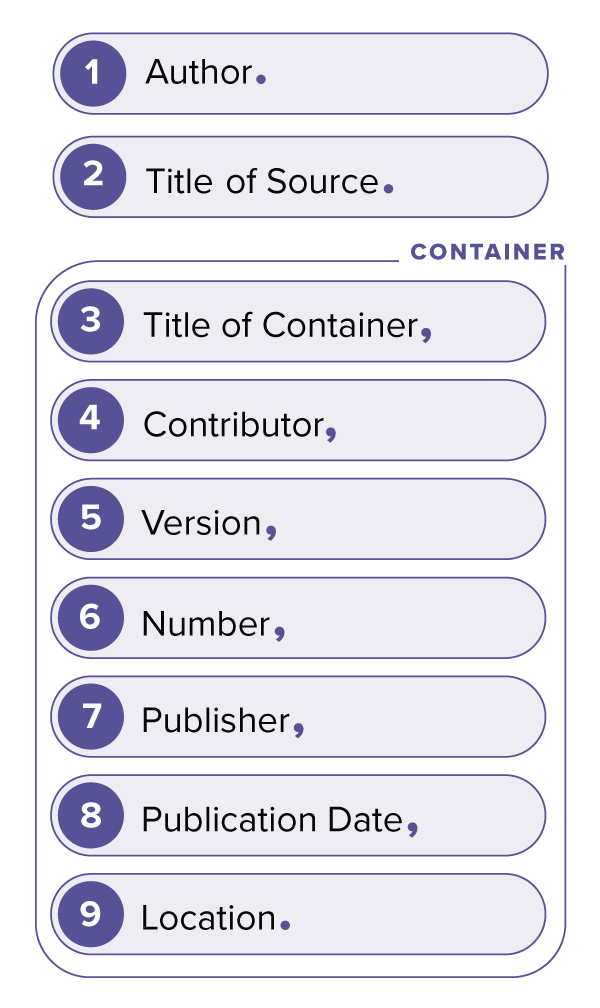MLA Basic Structure

The MLA Handbook Plus is available online through the Library to help you cite every source.
Log into Okta if prompted.
In-text citations are a brief parenthetical reference within the text of your paper that includes the author name and page number so your reader knows where to find the source of your information.
The author name points your reader to the source citation on the works cited list, and the page number shows where in the source you found the quotation or text you used.
More info on in-text citations: MLA Handbook 6.31-77
Larson, Lincoln R., et al. “The Future of Wildlife Conservation Funding: What Options Do U.S. College Students Support?” Conservation Science and Practice, vol. 3, no. 10, Oct. 2021, pp. 1–12. EBSCOhost, https://doi.org/10.1111/csp2.505.
The way you cite the author(s) in text depends on how you refer to their work in your text:
In the event that your source has no identifiable author name:
Parentheses are placed within the sentence punctuation and include author's last name and the page number where the relevant text is found.
Example:
Multiple authors:
Parentheses are placed within the sentence punctuation and include only the page number as the author is mentioned in text through use of a signal phrase.
Example:
In 2010, Niemi and Hanmer noted that college students are not studied as often as older voters (303).
Multiple authors:
Indent quotation half an inch from left margin. If the author name is used in text, put just the page number in parentheses following sentence punctuation. If the author name is not used in text, include in parentheses following sentence punctuation.
Example:
Niemi and Hanmer observe that
[w]ith the age of college students almost invariant and the meaning and measurement of their education and mobility questionable, several key variables used in models of voter turnout may well not account for varying rates of turnout among college students. Though there is considerable variation among students in hours worked, most student jobs do not mirror the careers they will ultimately obtain, so labor force participation may also be of limited explanatory power. (304)
Your Works Cited page includes every item you have cited in text and provides as much bibliographic information as you're able to find so your readers can locate the sources themselves.
Note that if the article is from the publisher website (which is considered self-contained) the URL falls within the punctuation following the page number(s).
Find more about these topics at the MLA Handbook sections mentioned throughout.
More info: MLA Handbook 5.3-22
More info: MLA Handbook 5.23-30
More info: MLA Handbook 5.31-37
More info: MLA Handbook 5.38-47
More info: MLA Handbook 5.48-50
More info: MLA Handbook 5.51-53
More info: MLA Handbook 5.54-67
More info: MLA Handbook 5.68-83
More info: MLA Handbook 5.84-99
Location makes reference to the container(s) of the work:
Formatting notes:
More info: MLA Handbook 5.105-119
These are some commonly used source types and how they're formatted. Remember that your Works Cited references will require a hanging indent (second and subsequent lines indented) of a half-inch.
Astor, Maggie. “What’s on the Minds of 12 Young Voters.” The New York Times, 19 Oct. 2022. NYTimes.com, https://www.nytimes.com/2022/10/19/us/politics/young-voters.html.
Cahill, Cathleen D. Recasting the Vote : How Women of Color Transformed the Suffrage Movement. E-book. The University of North Carolina Press, 2020. EBSCOhost, https://search.ebscohost.com/login.aspx?direct=true&db=e000xna&AN=2432685&site=ehost-live.
Gross, Neil. “Does College Make You Vote?” Chronicle of Higher Education, vol. 59, 24 Nov. 2012, p. B2. EBSCOhost, https://search.ebscohost.com/login.aspx?direct=true&db=aph&AN=83623976&site=ehost-live.
Larson, Lincoln R., et al. “The Future of Wildlife Conservation Funding: What Options Do U.S. College Students Support?” Conservation Science & Practice, vol. 3, no. 10, Oct. 2021, pp. 1–12. EBSCOhost, https://doi.org/10.1111/csp2.505.
Padilla, Dynahlee. “Tapping the Youth Vote.” Diverse: Issues in Higher Education, vol. 37, no. 18, Oct. 2020, pp. 20–21. EBSCOhost, https://search.ebscohost.com/login.aspx?direct=true&db=aph&AN=146573844&site=ehost-live.
Shea, Daniel M., and John Clifford Green. Fountain of Youth: Strategies and Tactics for Mobilizing America's Young Voters. Rowman & Littlefield, 2007.
Spagnuolo, Natalie, and Fady Shanouda. “Who Counts and Who Is Counted? Conversations around Voting, Access, and Divisions in the Disability Community.” Disability & Society, vol. 32, no. 5, June 2017, pp. 701–19. EBSCOhost, https://doi.org/10.1080/09687599.2017.1324765.
Wolfe, Rob. “America’s Best Colleges for Student Voting.” Washington Monthly, vol. 54, no. 9/10, Sept. 2022, pp. 60–63. EBSCOhost, https://search.ebscohost.com/login.aspx?direct=true&db=aph&AN=158554880&site=ehost-live.
These are some commonly used online source types and how they're formatted. Remember that your Works Cited references will require a hanging indent (second and subsequent lines indented) of a half-inch.
Notes:
“New Jersey.” Ballotpedia, https://ballotpedia.org/New_Jersey. Accessed 18 Oct. 2022.
Ballotpedia, https://ballotpedia.org/Main_Page. Accessed 18 Oct. 2022.
“Electoral College History.” National Archives, 18 Nov. 2019, https://www.archives.gov/electoral-college/history.
Astor, Maggie. “What’s on the Minds of 12 Young Voters.” The New York Times, 19 Oct. 2022, https://www.nytimes.com/2022/10/19/us/politics/young-voters.html.
Ng, Celeste [@pronounced_ing]. Photo of letter from Shirley Jackson. Twitter, 22 Jan. 2018, twitter.com/pronounced_ing/status/
955528799357231104.
This and other social media examples including text and video posts can be found in MLA Handbook Appendix 2.

MLA formats each work cited using a set of core elements that are included in the citation if applicable and punctuated appropriately.
Find more details about the core elements in the MLA Handbook Plus or use the fill-in template below.
Take the tutorial or watch the video. Slides are available below.

